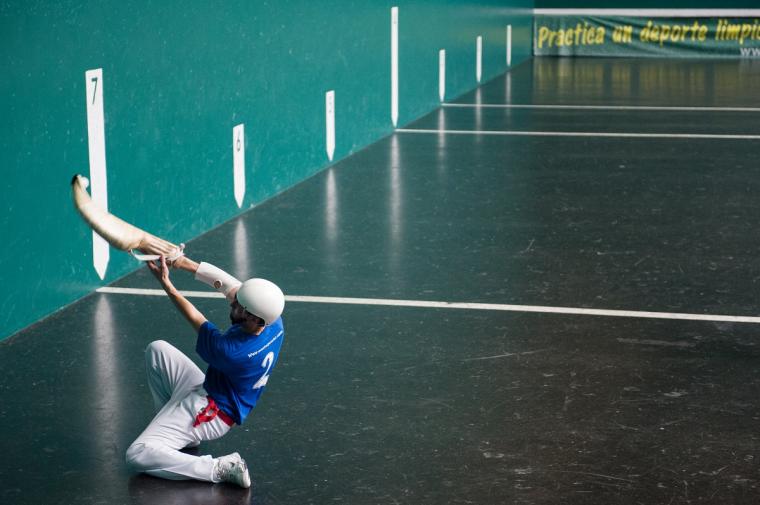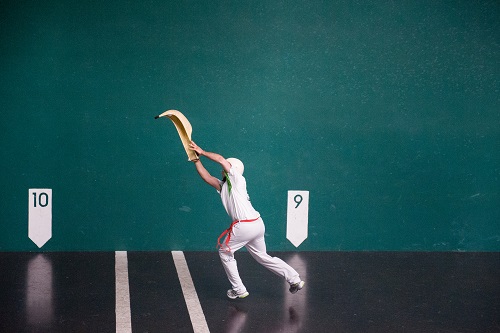
In its boom time, Jai alai was like roller disco: impenetrable to those who looked in from the outside and hot and happening for those who played and who followed it. Coincidentally, the last time it was also wildly popular was when roller disco was too, meaning the late 1970s and early 80s. These days, the sport is struggling to find players and to hold onto its facilities.
And the closure of the fronton, or playing facility, at Florida’s Casino at Dania Beach is not a positive sign.
Jai alai frontons (essentially high, three-sided 176-foot-long racquetball courts), are still found in Philippines and in Latin America. The sport has long been dominated by players from Spain, France, Cuba and Mexico. Its original popularity stateside was boosted by the fact that it was a basis for pari-mutuel betting. (Watch jai alai here).
There were, an article in SB Nation notes, frontons up and down the Eastern seaboard. “Presidents watched jai-alai with their wives. Ernest Hemingway bragged about getting to hang out with jai-alai players. In fact, during World War II he concocted a scheme in which jai-alai players would somehow lob grenades down the open hatches of unsuspecting German U-boats. Now, the sport seems like a relic, a vision into the past. It’s vestigial, like an appendix.”
And during a time as recent as the roller disco era, it was hard to get past the velvet rope and into the spectator gallery, much less onto the court.
Not any longer.
 “Gone are the celebrities like Paul Newman and John Travolta who used to crowd into sweaty, smoke-filled grandstands on a Saturday night to watch elite athletes fling a goatskin ball called a pelota at 130 mph (210 km/h) and catch it in a long straw basket-like device called a cesta,” notes WLRN in Miami, the city that is home to what may be the very last fronton in the United States, Magic City Casino.
“Gone are the celebrities like Paul Newman and John Travolta who used to crowd into sweaty, smoke-filled grandstands on a Saturday night to watch elite athletes fling a goatskin ball called a pelota at 130 mph (210 km/h) and catch it in a long straw basket-like device called a cesta,” notes WLRN in Miami, the city that is home to what may be the very last fronton in the United States, Magic City Casino.
“There was a time when the audience at the Miami Jai Alai fronton was so loud, the players on the court could barely hear their own thoughts,” commented SB nation. “Now though, the seats are almost all empty.”
And in an era of YouTube and online wagering, the jai alai gambling crowd that used to jam the frontons to lay down their money has dried up. Fewer players see the need to make the trip across international lines (the red tape is hardly worth it any longer) for the low amount of bets being placed – and the lack of attention accorded to athletes.
But Magic City Jai Alai is hoping it has the answer with a new deal that allows fans to purchase their own jai alai squad for a season, beginning in September 2022. The inaugural Battle Court season was won by the Cesta Cyclones squad in April, owned by Chris Cote, the longtime producer of the 'Dan Le Batard Show with Stugotz.'
"This is a rare chance to own a sports team without a lot of the downsides of traditional sports team ownership opportunities. When you become an owner of one of our squads, you get a seat at the table on Draft Day when key decisions are made. You also see the dedication that these players put forth on that court firsthand and how thrilling this game really is," said Scott Savin, Chief Operating Officer at Magic City Jai Alai. "We could not believe the level of engagement and the desire to win showcased by each of our owners in our first season and how passionate they have become about the game," said Savin.
Investing in a jai alai squad costs less than becoming part owner of, say, an MLB (or even an MiLB) team – but it’s still not cheap. Ownership opportunities are offered at a fixed cost of $100,000.
Magic City is also working to make the sport more appealing visually and physically. The fronton has been reduced by nearly 60 feet (18 meters) and the goatskin ball (formerly as hard as a hockey puck) has been replaced with a bouncier pelota that ricochets against plexiglass instead of the traditional granite wall. Magic City is also experimenting with the rules, creating so-called Battle Court matches resembling head-to-head singles tennis.
“The goal is to reach younger, online bettors for whom win-place-show wagering is a bygone era,” adds WLRN. “Content deals on free, advertising-supported platforms means games are reaching a potential audience of 115 million households and Magic City has teamed with platform BetRivers for online betting in seven states.”
Does that mean technology could be the sport’s savior?
Well…maybe. It’s still a long shot, given that most people have never heard of the sport. And jai alai has long been clinging to a slippery slope. Despite the fact that there was a time when frontons could be found not just in Florida but in New England, Nevada and other areas, a series of events took place that began propelling the sport downward.
A players’ strike, which happened in the 1980s and lasted more than three years, is often referred to as the first domino to fall. During the time the frontons sat empty, pro sports teams moved in. The Heat, Marlins and Panthers captured young people’s attention in Florida and in a mirror effect, local rec programs for children to enroll in basketball, football and basketball profited. Soccer was also growing and would continue to do so, promoted to national prominence by stars like Pelé who not only played sports that were seen on television but had roles in movies.
The betting angle, meanwhile, was hurt when lottery scratch-off games were introduced in 1988 and casinos rose throughout southern Florida, along with “cruises to nowhere,” so that bettors could travel to international waters to place their wagers. Other legal changes to casinos and to wagering as a whole allowed for more latitude – and less need for live sports. There were limitless opportunities for gambling for older folks and a lot of distractions for the younger group. Few children took up jai alai and a decreasing number of adults bet on it.
In other words, it was a perfect storm, and jai alai was all but washed away.
It’s easy enough to say the sport isn’t an American staple. It’s also possible to say the sport is a danger to those who take it up without understanding the risks. But, says SB Nation, that’s not the whole story.
“The truth is, this could be the future of any number of sports that are popular today. With a few small twists of fate, in time, this could be baseball or hockey or even football. If rule changes — precipitated by concussions — lead to an erosion of the fan base, football, like jai alai, might one day exist only for the purposes of gambling. It’s not impossible to imagine someone looking back a few generations from now on the hordes of drunken, screaming fans who fill up Cowboys Stadium and tailgate in their jerseys the same way we see those old jai alai patrons, with their suits and bourbon and cigars: anachronisms, ghosts from another time.”

